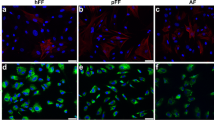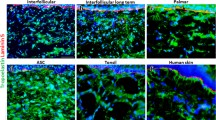Abstract.
Tissue-engineered skin substitutes may be a future remedy for burn wounds and chronic wounds, as wound contraction and scar formation cannot be prevented with the current standard treatment. The aim of this study therefore was to identify readily available sources of fibroblasts suitable for dermal substitution. Three different tissues were studied: dermal tissue from split-skin graft, subcutaneous fat tissue and eschar tissue obtained through debridement of burn wounds. We determined the cellular profile and the cell numbers immediately after isolation and after 2 and 14 days of fibroblast culture using flow cytometry and cell counting with a cytometer. In addition, parts of the isolated cell suspensions were seeded directly into a porous collagen dermal substitute to investigate contraction over time. Various cell types were isolated from the three different tissues, but after 14 days of culturing predominantly fibroblasts (>90%) were detected. Keratinocytes, granulocytes and macrophages, if present, disappeared within 14 days. In the cell populations derived from dermal tissue, the percentage of myofibroblasts had decreased significantly by day 14 (from 8% to 3%, P=0.028). In contrast, this percentage had increased in the cell populations derived from fat and eschar (from 23% to 40% and from 20% to 38%, respectively). The fibroblast yield from dermal tissue after 2 weeks of culturing (50×106 cells/g of tissue) was significantly higher than the yield from fat and eschar tissue (2×106 cells/g of each tissue, P=0.029). Immunohistochemistry of collagen matrices seeded and cultured with fat- and eschar-derived cells revealed a high prevalence of myofibroblasts, whereas hardly any myofibroblasts were detected in the matrices seeded with dermal cells. The contraction of the eschar matrices was highest (74±6% remaining area), whereas dermal matrices contracted significantly less (92±7% remaining area, P=0.029) with intermediate contraction for fat matrices. We conclude that fibroblast cultures can be established from dermal tissue, fat tissue and eschar tissue. Dermis is the best fibroblast source for use in skin substitutes as it yields the highest numbers of fibroblasts with minimal numbers of myofibroblasts.
Similar content being viewed by others
Author information
Authors and Affiliations
Additional information
Electronic Publication
Rights and permissions
About this article
Cite this article
van den Bogaerdt, A., van Zuijlen, P., van Galen, M. et al. The suitability of cells from different tissues for use in tissue-engineered skin substitutes. Arch Dermatol Res 294, 135–142 (2002). https://doi.org/10.1007/s00403-002-0305-3
Received:
Revised:
Accepted:
Published:
Issue Date:
DOI: https://doi.org/10.1007/s00403-002-0305-3




